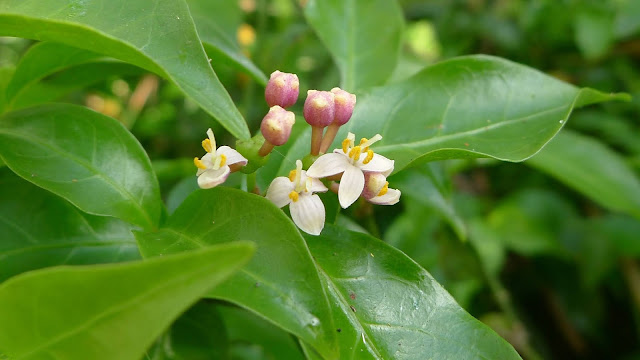PLANT OF THE WEEK
Sweet Morinda
You most probably know Australian climbing plants and would immediately think of Bower or Wonga wonga vine, either Pandorea jasminoides or Pandorea pandorana,
Very tropical looking climbers that suit all sorts of conditions around Australia.
But there’s some many more Australian native climbers that would suit our backyards and here’s one of them.
Common Name: Sweet MorindaVery tropical looking climbers that suit all sorts of conditions around Australia.
But there’s some many more Australian native climbers that would suit our backyards and here’s one of them.
Scientific name: Gynochthodes jasminoides syn. Morinda jasminoides
Family: Rubiaceae
Habit: scrambling climber to 6m. Adrian uses it to screen some ugly buildings.
What's in a name?
Morinda Latin morus = mulberry and
indicus = indian (referring to it being like an Indian Mulberry)
jasminoides
From the plant being Jasmine-likeThis pant is a native creeper found in eucalypt and rainforests along the east coast, across to Western Australia.You most probably know Australian climbing plants and would immediately think of Bower or Wonga wonga vine, either Pandorea jasminoides or Pandorea pandorana,
Very tropical looking climbers that suit all sorts of conditions around Australia.
But there’s some many more Australian native climbers that would suit our backyards and here’s one of them.
I'm talking with Adrian O’Malley, qualified horticulturist and native plant expert.
.Let’s find out…
Let’s just call it sweet Morinda or Morinda jasminoides.
Not overly floriferous but the flowers resemble those of jasmine with dense thick foliage that works well as a screen ugly buildings or scenery.
Flowers: Small clusters of 3-20 heads, but in Adrian's garden, it's not a prolific flowerer. There is some jasmine like scent but it's not overpowering. Mid spring to mid summer flowering.
Fruits: The main attraction some say because they're lumpy bright orange, 2cm in diameter.
Leaves: have an interesting bump in the centre called a "domatia."
the bumps are a symbiotic relationship with an insect that lives in the pits.The mite-habitat pits are so large that
they make conspicuous bumps on the upperside of the leaves, making the plant
easy to identify when it's not flowering or fruiting.



No comments:
Post a Comment